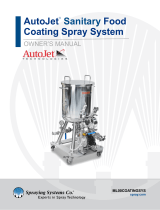17
SECTION 8
SPARE PARTS
Part Number Descripon
1/4BBCV-SS10 CHECK VALVE, 303SS
23220-1/4FX1/4F PLUG VALVE, 23220-1/4FX1/4F PLUG VALVE ASB.BRASS
AA10000-72440T-EPM8 Heated PulsaJet Spray Nozzle - Threaded Connecon.
LS00LMT100 Switch, Point level sensor, high frequency capacitance, for water-based media
OR004061T162 O-ring, Square, Buna-N, 70 Duro
160TS16MV0001W5_SU01 Auto-Rell Level Sensor
PL00416TV VENT, AIR, AUTOMATIC, 1/8" MALE NPT BRASS / BRASS, 115 PSI, 140°- 240°F
FT003133-JT_AC20 20 Jacketed Hose
PR00301DFW254D Pressure, gauge, 0 - 60 psi, stainless steel connecon and case, plasc lense,
dry case 2-1/2" diameter dial, 1/4" NPT male connecon, 200F max
PU00CRI12WASH1P Pump, Centrifugal, 304SS weed parts, Wash down motor 1/3HP, 115/230VAC
single phase, 3450rpm, 56C, 60hz
CP12290-7-SS Strainer Screen, 200 Mesh, SS
TE00TM4341 Sensor, temperature, RTD, 1/2" NPT, 150mm p length, -40...302F range, 316
stainless steel, 4-pin micro DC connector
HT00BEN314S6C2 Heater, 3KW, 230VAC, 2 Alloy 800 elements, 304SS Nut (1-1/4 NPT), 15" Long.
VA00366FCSV Valve, Manual, 2-Way, 1/2" 316SS.
VA0046495K23_AC01 Valve, Manual Ball Valve, 2-way, Threaded, Jacketed, 316SS.
VAXXEASSBBAFAF0_AC01 Valve, Manual Ball Valve, 3-way, Threaded, Jacketed, 316SS
VA007768K16 Check Valve, 1/4" NPT male x 1/4" NPT male, 1 PSI cracking pressure
VC00110-BC 1/4" Pressure Regulator, 1/4 NPT (female) End Plates, 0-100 PSI
VC003823T321 Regulator - Air/Water - For lling Heang Circuit 0-300 PSI INLET
VA008P014612C2_AC01 Ball Valve, 3-Way, Threaded, 316SS, Air Acctuated with Spring Return, Heated.
VC0098905K15 Valve, Safety Relief, 1/4" NPT, ASME poppet type, 304 stainless steel, 100 PSI
VC00BUDSSVTSS Valve, Bushing, 1/2"NPTm X 3/8"NPTf connecons, 316SS Body/Spring
























